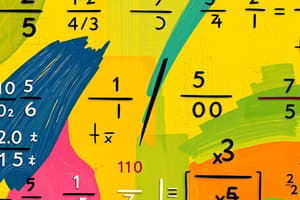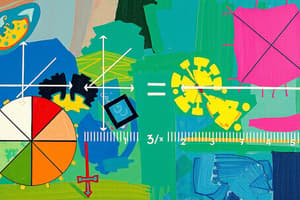Podcast
Questions and Answers
What is the result of multiplying the fractions 1/2 and 3/4?
What is the result of multiplying the fractions 1/2 and 3/4?
- 3/4
- 3/8 (correct)
- 3/2
- 1/8
What is the definition of multiplication?
What is the definition of multiplication?
- A way of repeated addition. (correct)
- A way of repeated subtraction.
- A way of repeated exponentiation.
- A way of repeated division.
What is the result of dividing the fraction 3/4 by 2/3?
What is the result of dividing the fraction 3/4 by 2/3?
- 2/1
- 9/8 (correct)
- 4/3
- 9/16
What is the symbol for multiplication?
What is the symbol for multiplication?
Which of the following is an example of an improper fraction?
Which of the following is an example of an improper fraction?
What is the result of 2 × (3 + 4) using the distributive property?
What is the result of 2 × (3 + 4) using the distributive property?
What is the definition of division?
What is the definition of division?
What is the result of adding the fractions 1/4 and 1/6?
What is the result of adding the fractions 1/4 and 1/6?
Which of the following fractions are equivalent?
Which of the following fractions are equivalent?
What is the numerator in the fraction 3/4?
What is the numerator in the fraction 3/4?
Flashcards are hidden until you start studying
Study Notes
Multiplication
- Definition: Multiplication is a way of repeated addition.
- Symbol: The multiplication symbol is × (times).
- Example: 2 × 3 = 2 + 2 + 2 = 6
- Properties:
- Commutative Property: The order of the numbers being multiplied does not change the result. (e.g., 2 × 3 = 3 × 2)
- Associative Property: The order in which numbers are multiplied does not change the result. (e.g., (2 × 3) × 4 = 2 × (3 × 4))
- Distributive Property: Multiplication can be distributed over addition. (e.g., 2 × (3 + 4) = 2 × 3 + 2 × 4)
- Real-world applications: Multiplication is used in everyday life, such as counting blocks, measuring ingredients, and calculating areas.
Division
- Definition: Division is the opposite of multiplication.
- Symbol: The division symbol is ÷ (divided by).
- Example: 6 ÷ 2 = 3 (because 2 × 3 = 6)
- Properties:
- Inverse Operation: Division is the inverse operation of multiplication.
- Remainders: In division, the remainder is the amount left over after dividing. (e.g., 7 ÷ 2 = 3 with a remainder of 1)
- Real-world applications: Division is used in everyday life, such as sharing toys, dividing a pizza, and measuring time.
Fractions
- Definition: A fraction is a way to represent part of a whole.
- Symbol: A fraction is written as a numerator (top number) over a denominator (bottom number), separated by a horizontal line.
- Example: 1/2 (one half)
- Types of fractions:
- Proper fractions: The numerator is less than the denominator. (e.g., 1/2)
- Improper fractions: The numerator is greater than or equal to the denominator. (e.g., 3/2)
- Mixed numbers: A combination of a whole number and a proper fraction. (e.g., 1 1/2)
- Operations with fractions:
- Equivalence: Two fractions are equivalent if they represent the same amount. (e.g., 1/2 = 2/4)
- Addition and subtraction: Fractions can be added or subtracted by finding a common denominator.
- Multiplication: Fractions can be multiplied by multiplying the numerators and denominators separately.
- Division: Fractions can be divided by inverting the second fraction (i.e., flipping the numerator and denominator) and then multiplying.
Studying That Suits You
Use AI to generate personalized quizzes and flashcards to suit your learning preferences.



